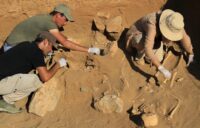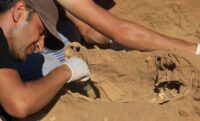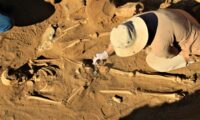 The skeletal remains of four individuals, three adults and one infant buried in a broken amphora, have been discovered in the ancient port city of Anemurium, modern-day Mersin on the Mediterranean coast of southcentral Turkey. This is the first neonate amphora burial discovered in Anemurium.
The skeletal remains of four individuals, three adults and one infant buried in a broken amphora, have been discovered in the ancient port city of Anemurium, modern-day Mersin on the Mediterranean coast of southcentral Turkey. This is the first neonate amphora burial discovered in Anemurium.
The four individuals were buried together, but not with the same care. The newborn was laid to rest in the amphora and neatly buried. The three adults were buried directly in the ground in a more haphazard arrangement. Archaeologists believe this was a family group, and that the baby who died before it barely lived received special funerary attention.
 Pot burials, known as enchytrismos, were extremely common in the Greek world and the primary practice for the burial of fetuses, babies and small children. For example in just one necropolis, the Kylindra Cemetery on the island of Astylapaia, there are than 3,400 pot burials of infants, the largest assemblage of ancient children’s remains in the world.
Pot burials, known as enchytrismos, were extremely common in the Greek world and the primary practice for the burial of fetuses, babies and small children. For example in just one necropolis, the Kylindra Cemetery on the island of Astylapaia, there are than 3,400 pot burials of infants, the largest assemblage of ancient children’s remains in the world.
Greco-Roman funerary practices required burial of the dead outside of city walls, often in necropolises in use for generations. Because infant and child mortality was so high, babies and children under three were often buried outside of formal funerary spaces. In this instance, the baby was buried under what appears to have been a colonnaded street, not in the city’s necropolis.
 This year’s excavation has unearthed seven burials at this site — five adults, one child and the baby in the amphora. Last year’s excavation at the Anemurium necropolis unearthed eight burials, so if the site where the amphora burial was found was in fact a street, it had an unusually high number of graves dug on it. Archaeologists hypothesize that there may have been a church in this area, not a colonnaded city street, and that the deceased were buried in the churchyard.
This year’s excavation has unearthed seven burials at this site — five adults, one child and the baby in the amphora. Last year’s excavation at the Anemurium necropolis unearthed eight burials, so if the site where the amphora burial was found was in fact a street, it had an unusually high number of graves dug on it. Archaeologists hypothesize that there may have been a church in this area, not a colonnaded city street, and that the deceased were buried in the churchyard.